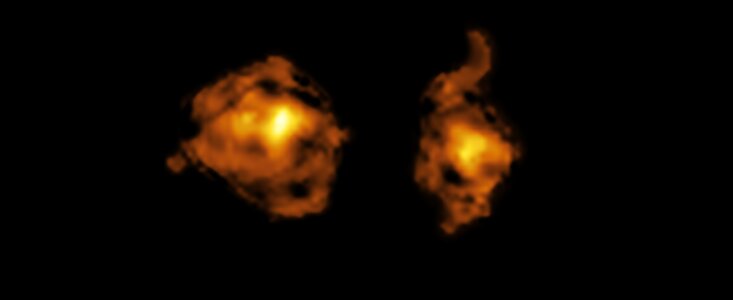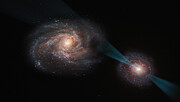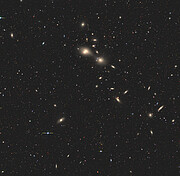Komunikat prasowy
Kosmiczny turniej rycerski: astronomowie obserwują parę galaktyk w odległym kosmicznym pojedynku
21 maja 2025

Po raz pierwszy astronomowie są świadkami gwałtownej kosmicznej kolizji, w której jedna z galaktyk przebija drugą intensywnym promieniowaniem. Opublikowane dzisiaj w „Nature” wyniki badań pokazują, jak to promieniowanie osłania zdolność zranionej galaktyki do tworzenia nowych gwiazd. W nowych badaniach połączono obserwacje z Bardzo Dużego Teleskopu (VLT), należącego do Europejskiego Obserwatorium Południowego (ESO), oraz z Atacama Large Millimeter/submillimeter Array (ALMA), ukazując makabryczne szczegóły tej galaktycznej bitwy.
W odległych otchłaniach Wszechświata, dwie galaktyki toczą emocjonująca walkę. Pędzą na siebie z prędkością 500 km/s na kursie kolizyjnym, po to tylko aby musnąć się, wycofać i przygotować na kolejną rundę. I tak w kółko. „Dlatego nazwaliśmy ten system ‘kosmicznym turniejem rycerskim’” mówi Pasquier Noterdaeme, współkierownik badań i naukowiec z Institut d'Astrophysique de Paris we Francji oraz z French-Chilean Laboratory for Astronomy w Chile, porównując sytuację do średniowiecznego turnieju rycerskiego. Ale ci galaktyczni rycerze niekoniecznie są honorowi, jedna z galaktyk ma bardzo niesprawiedliwą przewagę: używa kwazara, aby przebijać przeciwniczkę włócznią promieniowania.
Kwazary to jasne jądra niektórych odległych galaktyk, które są zasilane przez supermasywne czarne dziury, uwalniając olbrzymie ilości promieniowania. Zarówno kwazary, jak i zderzenia galaktyk były znacznie powszechniejsze, zdarzały się znacznie częściej w ciągu pierwszych kilku miliardów lat ewolucji Wszechświata. Zatem obserwując je astronomowie patrzą w odległą przeszłość przy pomocy potężnych teleskopów. Światło od opisywanego „kosmicznego turnieju rycerskiego” potrzebowało ponad 11 miliardów lat, aby do nas dotrzeć, widzimy więc galaktyki w momencie, gdy Wszechświat miał jedynie 18% obecnego wieku.
“Widzimy tutaj po raz pierwszy efekt, jaki promieniowanie kwazara wywiera bezpośrednio na wewnętrzną strukturę gazu w zwykłej galaktyce” wyjaśnia współkierownik badań Sergei Balashev, naukowiec z Ioffe Institute w Petersburgu w Rosji. Nowe obserwacje wskazują, że promieniowanie uwolnione przez kwazar rozbija obłoki gazu i pyłu w zwykłej galaktyce, pozostawiając za sobą jedynie najmniejsze, najgęstsze obszary. Obszary te są prawdopodobnie zbyt małe, aby były zdolne to formowania gwiazd, co pozostawia zranioną galaktykę z mniejszą liczbę gwiezdnych wylęgarni, prowadząc do dramatycznej transformacji.
Ale nie tylko galaktyczna ofiara ulega transformacji. Balashev wyjaśnia: „Uważa się, że takie galaktyczne merdżery dostarczają olbrzymie ilości gazu do supermasywnych czarnych dziur obecnych w centrach galaktyk.” W tym kosmicznym pojedynku nowe zasoby paliwa są przenoszone w zasięg czarnej dziury zasilającej kwazar. Gdy czarna dziura „żeruje”, kwazar może kontynuować niszczycielski atak.
Badania przeprowadzono przy pomocy ALMA i instrumentu X-shooter na teleskopie VLT, należącym do ESO. Oba teleskopy znajdują się na chilijskiej pustyni Atakama. Wysoka rozdzielczość ALMA pomogła astronomom wyraźnie rozróżnić dwie zderzające się galaktyki, które są tak blisko siebie, że wyglądały jak jeden obiekt w poprzednich obserwacjach. Dzięki X-shooter, badacze przeanalizowali światło kwazara, gdy przechodzi ono przez zwykłą galaktykę. Pozwoliło to zespołowi na zbadanie, w jaki sposób galaktyka ucierpiała od promieniowania kwazara w tej kosmicznej walce.
Obserwacje przy pomocy większych, potężniejszych teleskopów mogą ujawnić więcej na temat kolizji takich, jak opisywana. Jak mówi Noterdaeme, teleskop taki, jak Ekstremalnie Wielki Teleskop (ELT), budowany przez ESO, „na pewno pozwoli na posunięcie naprzód głębokich badań tego i innych systemów, aby lepiej zrozumieć ewolucję kwazarów i ich wpływ na macierzystą i sąsiednie galaktyki.”
Więcej informacji
Wyniki badań opublikowano w artykule pt. „Quasar radiation transforms the gas in a merging companion galaxy”, który ukaże się w Nature (doi: 10.1038/s41586-025-08966-4)
Skład zespołu badawczego: S. Balashev (Ioffe Institute, St Petersburg, Rosja), P. Noterdaeme (Institut d’Astrophysique de Paris, Paryż, Francja [IAP] & French-Chilean Laboratory for Astronomy [FCLA], Chile), N. Gupta (Inter-University Centre for Astronomy, Pune, Indie [IUCAA]), J.K. Krogager (Université Lyon I, Lyon, Francja & FCLA), F. Combes (Collège de France, Paryż, Franja), S. López (Universidad de Chile [UChile]), P. Petitjean (IAP), A. Omont (IAP), R. Srianand (IUCAA), R. Cuellar (UChile).
Atacama Large Millimeter/submillimeter Array (ALMA) jest międzynarodowym kompleksem badawczym w ramach partnerstwa pomiędzy ESO, U.S. National Science Foundation (NSF) oraz National Institutes of Natural Sciences (NINS) of Japan, we współpracy z Chile. ALMA jest finansowana przez ESO w imieniu Krajów Członkowskich, przez NSF we współpracy z National Research Council of Canada (NRC) i National Science Council of Taiwan (NSC) oraz przez NINS we współpracy z Academia Sinica (AS) na Tajwanie i Korea Astronomy and Space Science Institute (KASI). Budowa i zarządzanie ALMA są kierowane przez ESO w imieniu Krajów Członkowskich, przez National Radio Astronomy Observatory (NRAO), zarządzane przez Associated Universities, Inc. (AUI), w imieniu Ameryki Północnej oraz przez National Astronomical Observatory of Japan (NAOJ) w imieniu Azji Wschodniej. Joint ALMA Observatory (JAO) umożliwia zunifikowane kierowanie i zarządzanie budową, testowaniem i działaniem ALMA.
Europejskie Obserwatorium Południowe (ESO) umożliwia naukowcom z całego świata na odkrywanie tajemnic Wszechświata z korzyścią dla nas wszystkich. Projektujemy, budujemy i zarządzamy światowej klasy obserwatoriami naziemnymi – których astronomowie używają do odpowiadania na ciekawe pytania i szerzenia fascynacji astronomią – a także promujemy międzynarodową współpracę w astronomii. Ustanowione w 1962 roku jako organizacja międzynarodowa, ESO jest wspierane przez 16 krajów członkowskich (Austria, Belgia, Czechy, Dania, Finlandia, Francja, Hiszpania, Irlandia, Holandia, Niemcy, Polska, Portugalia, Szwajcaria, Szwecja, Wielka Brytania oraz Włochy), a także Chile jako kraj gospodarz, oraz Australię jako strategicznego partnera. Siedziba ESO, a także jego centrum popularyzacji nauki i planetarium (ESO Supernova) znajdują się w pobliżu Monachium w Niemczech, natomiast chilijska pustynia Atakama – niesamowite miejsce z wyjątkowymi warunkami do obserwacji nieba – jest domem dla naszych teleskopów. ESO zarządza trzema lokalizacjami obserwacyjnymi w Chile: La Silla, Paranal i Chajnantor. W Paranal ESO posiada teleskop VLT (Very Large Telescope – Bardzo Duży Teleskop) oraz dwa teleskopy do przeglądów nieba. VISTA pracuje w podczerwieni, VLT Survey Telescope w zakresie widzialnym. W Paranal ESO zarządza także południowym obserwatorium CTA (Cherenkov Telescope Array South) – największym na świecie i najbardziej czułym obserwatorium promieniowania gamma. Wspólnie z międzynarodowymi partnerami ESO zarządza także radioteleskopami APEX i ALMA, które są instrumentami do obserwacji nieba w zakresach milimetrowym i submilimetrowym. Na Cerro Armazones, niedaleko Paranal, budujemy „największe oko świata na niebo”, czyli Ekstremalnie Wielki Teleskop (Extremely Large Telescope, ELT). Nasza działalność w Chile jest zarządzana z biur ESO w Santiago, gdzie współpracujemy też z chilijskimi partnerami.
Linki
- Publikacja naukowa
- Zdjęcia VLT
- Zdjęcia ALMA
- Dowiedz się więcej o Ektremalnie Wielkim Teleskopie na naszej dedykowanej witrynie i w pakiecie prasowym
- Dla dziennikarzy: subskrybuj, aby otrzymywć w swoim języku nasze komunikaty prasowe z embargo medialnym oraz zaaplikuj, aby wziąć udział w strategicznej wizycie medialnej w ESO 2025 (częściowo dofinansowanej) (NOWOŚĆ)
- Dla naukowców: jesli masz ciekawe wyniki, zgłoś swoje badania
- Nowe analizy ESO potwierdzają poważne szkody, które spowoduje planowany kompleks przemysłowy w pobliżu Paranal
Kontakt
Pasquier Noterdaeme
Institut d'Astrophysique de Paris
Paris, France
Tel.: +33 1 44 32 81 65
E-mail: noterdaeme@iap.fr
Sergei Balashev
Ioffe Institute
St Petersburg, Russia
Tel.: +7 921 970 2553
E-mail: s.balashev@gmail.com
Bárbara Ferreira
ESO Media Manager
Garching bei München, Germany
Tel.: +49 89 3200 6670
Tel. kom.: +49 151 241 664 00
E-mail: press@eso.org
Krzysztof Czart (Kontakt dla mediów Polska)
Sieć Popularyzacji Nauki ESO
oraz Urania - Postępy Astronomii
Toruń, Polska
Tel.: +48 513 733 282
E-mail: eson-poland@eso.org
O komunikacie
| Komunikat nr: | eso2509pl |
| Science data: | 2025Natur.641.1137B |
Our use of Cookies
We use cookies that are essential for accessing our websites and using our services. We also use cookies to analyse, measure and improve our websites’ performance, to enable content sharing via social media and to display media content hosted on third-party platforms.
ESO Cookies Policy
The European Organisation for Astronomical Research in the Southern Hemisphere (ESO) is the pre-eminent intergovernmental science and technology organisation in astronomy. It carries out an ambitious programme focused on the design, construction and operation of powerful ground-based observing facilities for astronomy.
This Cookies Policy is intended to provide clarity by outlining the cookies used on the ESO public websites, their functions, the options you have for controlling them, and the ways you can contact us for additional details.
What are cookies?
Cookies are small pieces of data stored on your device by websites you visit. They serve various purposes, such as remembering login credentials and preferences and enhance your browsing experience.
Categories of cookies we use
Essential cookies (always active): These cookies are strictly necessary for the proper functioning of our website. Without these cookies, the website cannot operate correctly, and certain services, such as logging in or accessing secure areas, may not be available; because they are essential for the website’s operation, they cannot be disabled.
Functional Cookies: These cookies enhance your browsing experience by enabling additional features and personalization, such as remembering your preferences and settings. While not strictly necessary for the website to function, they improve usability and convenience; these cookies are only placed if you provide your consent.
Analytics cookies: These cookies collect information about how visitors interact with our website, such as which pages are visited most often and how users navigate the site. This data helps us improve website performance, optimize content, and enhance the user experience; these cookies are only placed if you provide your consent. We use the following analytics cookies.
Matomo Cookies:
This website uses Matomo (formerly Piwik), an open source software which enables the statistical analysis of website visits. Matomo uses cookies (text files) which are saved on your computer and which allow us to analyze how you use our website. The website user information generated by the cookies will only be saved on the servers of our IT Department. We use this information to analyze www.eso.org visits and to prepare reports on website activities. These data will not be disclosed to third parties.
On behalf of ESO, Matomo will use this information for the purpose of evaluating your use of the website, compiling reports on website activity and providing other services relating to website activity and internet usage.
Matomo cookies settings:
Additional Third-party cookies on ESO websites: some of our pages display content from external providers, e.g. YouTube.
Such third-party services are outside of ESO control and may, at any time, change their terms of service, use of cookies, etc.
YouTube: Some videos on the ESO website are embedded from ESO’s official YouTube channel. We have enabled YouTube’s privacy-enhanced mode, meaning that no cookies are set unless the user actively clicks on the video to play it. Additionally, in this mode, YouTube does not store any personally identifiable cookie data for embedded video playbacks. For more details, please refer to YouTube’s embedding videos information page.
Cookies can also be classified based on the following elements.
Regarding the domain, there are:
- First-party cookies, set by the website you are currently visiting. They are stored by the same domain that you are browsing and are used to enhance your experience on that site;
- Third-party cookies, set by a domain other than the one you are currently visiting.
As for their duration, cookies can be:
- Browser-session cookies, which are deleted when the user closes the browser;
- Stored cookies, which stay on the user's device for a predetermined period of time.
How to manage cookies
Cookie settings: You can modify your cookie choices for the ESO webpages at any time by clicking on the link Cookie settings at the bottom of any page.
In your browser: If you wish to delete cookies or instruct your browser to delete or block cookies by default, please visit the help pages of your browser:
Please be aware that if you delete or decline cookies, certain functionalities of our website may be not be available and your browsing experience may be affected.
You can set most browsers to prevent any cookies being placed on your device, but you may then have to manually adjust some preferences every time you visit a site/page. And some services and functionalities may not work properly at all (e.g. profile logging-in, shop check out).
Updates to the ESO Cookies Policy
The ESO Cookies Policy may be subject to future updates, which will be made available on this page.
Additional information
For any queries related to cookies, please contact: pdprATesoDOTorg.
As ESO public webpages are managed by our Department of Communication, your questions will be dealt with the support of the said Department.






